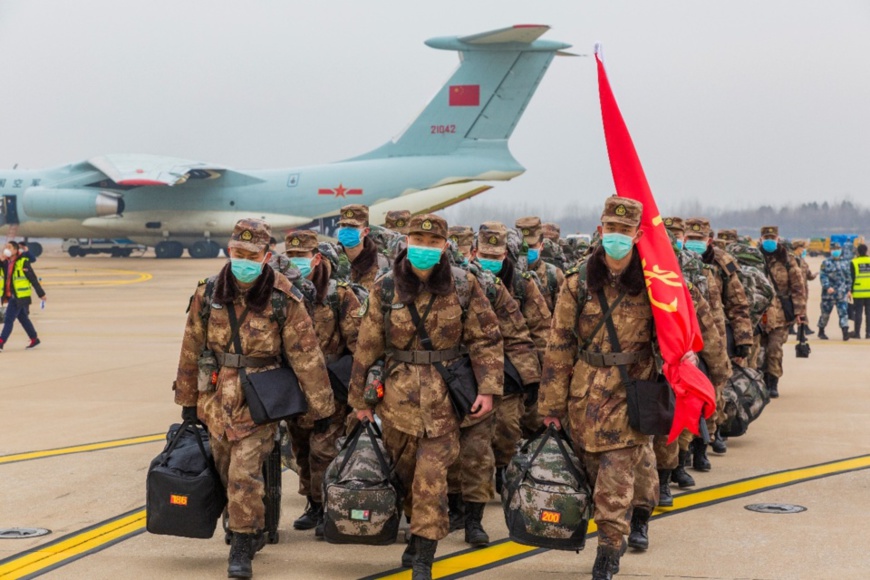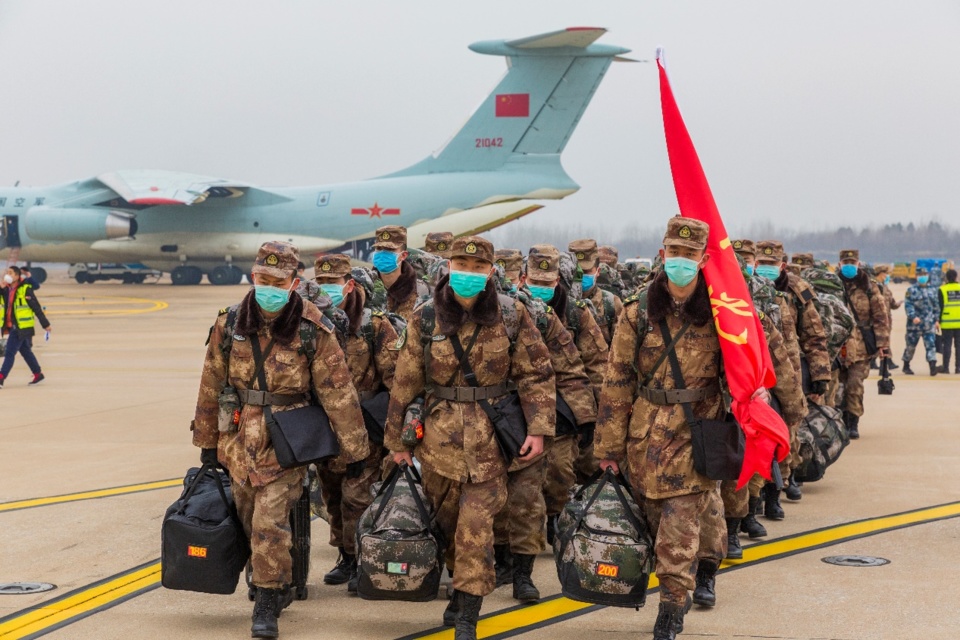By People’s Daily

A total of 1,400 medical staff from the Chinese army are tasked with treating patients with pneumonia caused by the novel coronavirus in Huoshenshan Hospital starting from Feb.3. (Photo by Zhang Wujun/ People’s Daily)
Huoshenshan (Fire God Mountain) Hospital, the first makeshift hospital built for treating patients infected with the novel coronavirus in Wuhan, capital of central China’s Hubei Province, was officially delivered to medical teams of the Chinese army on Feb. 2.
It was not an easy task to build the hospital in just days which covers a total area of 50,000 square meters with a floor space of 33,900 square meters.
The construction of the Huoshenshan Hospital was a race against the epidemic, and every single second was made full use of. It was built by over 6,000 constructors in shifts, and nearly 1,000 large-scale machinery and vehicles were working at site around the clock. The construction once again demonstrated China’s strength and speed of building infrastructure.
“The schedule was tight. A hospital of this size normally takes at least one month to build, but we just used ten days,” said Shen Kai, site manager of the technical team of China Construction Third Engineering Bureau, the constructor of the Huoshenshan Hospital.
“Our workers were on two shifts and the design team even had only two hours of sleep each day. It’s common to stay up the whole night working,” Shen disclosed.
The “mission impossible” was completed in the face of extremely serious epidemic situation as the spreading of the novel coronavirus outran the continuously expending number of hospital beds at designated hospitals.
“Based on the experience of combating the severe acute respiratory syndromes (SARS) in 2003, we know that building a new hospital for treating patients with the epidemic disease can significantly relieve the current pressure on hospitals and reduce cross infection,” said a medical expert who has taken part in China’s battle against the SARS epidemic.
The newly-built hospital, upon its operation, also plays an important role in reducing social panic, the expert added.
In April 2003, Beijing Xiaotangshan Hospital was built to treat the SARS victims in Beijing. The hospital, with 1,000 beds, received one seventh of the country’s patients infected with the SARS virus in two months, and no medical worker was infected, creating a miracle in the history of medical science.
As a specialized hospital for infectious disease, Huoshenshan Hospital was built on strict standards in every aspect, from the layout of the wards to the design of sewer tunnels. It has extremely harsh requirements on protective measures.
Learning from the construction of Beijing Xiaotangshan Hospital, Huoshenshan Hospital is superior to its “predecessor”.
The hospital is mainly used to treat confirmed patients. It has 1,000 beds and includes intensive care units and general wards. In addition, the hospital also has supporting departments specializing in infection prevention and control, examination, special diagnosis, and radiodiagnosis.
The hospital takes strict quarantine measures in an attempt to avoid cross infection and maximize the health and safety of medical workers.
Wards in Huoshenshan Hospital are elevated 30 centimeters above the ground. Every ward has an independent restroom, and most rooms in the hospital are under negative pressure, so that they can avoid cross infection caused by viruses in airflow.
All contaminated resources in Huoshenshan Hospital are disinfected in a centralized treatment station. The hospital has installed rainwater and sewage treatment system, as well as a ventilation system, and all contaminated substances are discharged only when meeting standards after going through strict disinfection and filtration procedures.
Meanwhile, the hospital has covered 50,000 square meters of impermeable film on the ground to ensure that contaminants don’t percolate into the soil and water.
After the construction of Huoshenshan Hospital was broadcast on livestreaming platforms, tens of millions of netizens became online supervisors. It was beyond imagination that a construction site could become the center of the focus for millions of people.
“This is not simply a livestreaming show carried out at a construction site, but a hope of defeating the epidemic.
Everyone wants to see it proceed fast, and faster.” Such online comments were frequently posted during the past days.
With the army of excavators and construction workers working non-stop, as well as materials continuously being transported to Wuhan, the whole country is preparing for the battle against the novel coronavirus in an amazing speed, said a foreigner who has watched the livestreaming.
World Health Organization (WHO) Director-General Tedros Adhanom Ghebreyesus praised China’s efforts to fight the epidemic, saying that he has never seen such scale of mobilization in his life.
Many people may have paid attention to the large Chinese hospital built in ten days, but the country is taking more measures for the battle, said the WHO chief, adding that he believes that these measures will help China turn the table.
After the completion of the construction of Huoshenshan Hospital, many construction workers and machinery were immediately transferred to the construction site of Leishenshan (Thunder God Mountain) Hospital, the second hospital built for the treatment of the novel coronavirus in Wuhan.
With the approval of Chairman of the Central Military Commission Xi Jinping, the Chinese army dispatched a total of 1,400 medical staff to Huoshenshan Hospital. Tasked with treating patients in the hospital starting from Monday, these medical staff have rich experience in treating infectious diseases.
Many of them have taken part in the combats against the epidemics including SARS in Beijing Xiaotangshan Hospital and Ebola in Sierra Leone and Liberia.
It was not an easy task to build the hospital in just days which covers a total area of 50,000 square meters with a floor space of 33,900 square meters.
The construction of the Huoshenshan Hospital was a race against the epidemic, and every single second was made full use of. It was built by over 6,000 constructors in shifts, and nearly 1,000 large-scale machinery and vehicles were working at site around the clock. The construction once again demonstrated China’s strength and speed of building infrastructure.
“The schedule was tight. A hospital of this size normally takes at least one month to build, but we just used ten days,” said Shen Kai, site manager of the technical team of China Construction Third Engineering Bureau, the constructor of the Huoshenshan Hospital.
“Our workers were on two shifts and the design team even had only two hours of sleep each day. It’s common to stay up the whole night working,” Shen disclosed.
The “mission impossible” was completed in the face of extremely serious epidemic situation as the spreading of the novel coronavirus outran the continuously expending number of hospital beds at designated hospitals.
“Based on the experience of combating the severe acute respiratory syndromes (SARS) in 2003, we know that building a new hospital for treating patients with the epidemic disease can significantly relieve the current pressure on hospitals and reduce cross infection,” said a medical expert who has taken part in China’s battle against the SARS epidemic.
The newly-built hospital, upon its operation, also plays an important role in reducing social panic, the expert added.
In April 2003, Beijing Xiaotangshan Hospital was built to treat the SARS victims in Beijing. The hospital, with 1,000 beds, received one seventh of the country’s patients infected with the SARS virus in two months, and no medical worker was infected, creating a miracle in the history of medical science.
As a specialized hospital for infectious disease, Huoshenshan Hospital was built on strict standards in every aspect, from the layout of the wards to the design of sewer tunnels. It has extremely harsh requirements on protective measures.
Learning from the construction of Beijing Xiaotangshan Hospital, Huoshenshan Hospital is superior to its “predecessor”.
The hospital is mainly used to treat confirmed patients. It has 1,000 beds and includes intensive care units and general wards. In addition, the hospital also has supporting departments specializing in infection prevention and control, examination, special diagnosis, and radiodiagnosis.
The hospital takes strict quarantine measures in an attempt to avoid cross infection and maximize the health and safety of medical workers.
Wards in Huoshenshan Hospital are elevated 30 centimeters above the ground. Every ward has an independent restroom, and most rooms in the hospital are under negative pressure, so that they can avoid cross infection caused by viruses in airflow.
All contaminated resources in Huoshenshan Hospital are disinfected in a centralized treatment station. The hospital has installed rainwater and sewage treatment system, as well as a ventilation system, and all contaminated substances are discharged only when meeting standards after going through strict disinfection and filtration procedures.
Meanwhile, the hospital has covered 50,000 square meters of impermeable film on the ground to ensure that contaminants don’t percolate into the soil and water.
After the construction of Huoshenshan Hospital was broadcast on livestreaming platforms, tens of millions of netizens became online supervisors. It was beyond imagination that a construction site could become the center of the focus for millions of people.
“This is not simply a livestreaming show carried out at a construction site, but a hope of defeating the epidemic.
Everyone wants to see it proceed fast, and faster.” Such online comments were frequently posted during the past days.
With the army of excavators and construction workers working non-stop, as well as materials continuously being transported to Wuhan, the whole country is preparing for the battle against the novel coronavirus in an amazing speed, said a foreigner who has watched the livestreaming.
World Health Organization (WHO) Director-General Tedros Adhanom Ghebreyesus praised China’s efforts to fight the epidemic, saying that he has never seen such scale of mobilization in his life.
Many people may have paid attention to the large Chinese hospital built in ten days, but the country is taking more measures for the battle, said the WHO chief, adding that he believes that these measures will help China turn the table.
After the completion of the construction of Huoshenshan Hospital, many construction workers and machinery were immediately transferred to the construction site of Leishenshan (Thunder God Mountain) Hospital, the second hospital built for the treatment of the novel coronavirus in Wuhan.
With the approval of Chairman of the Central Military Commission Xi Jinping, the Chinese army dispatched a total of 1,400 medical staff to Huoshenshan Hospital. Tasked with treating patients in the hospital starting from Monday, these medical staff have rich experience in treating infectious diseases.
Many of them have taken part in the combats against the epidemics including SARS in Beijing Xiaotangshan Hospital and Ebola in Sierra Leone and Liberia.
 Menu
Menu
 China’s Huoshenshan Hospital a race against epidemic
China’s Huoshenshan Hospital a race against epidemic
















